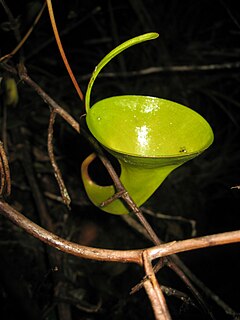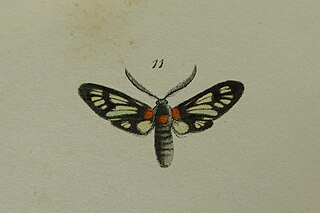
Bromus is a large genus of grasses, classified in its own tribe Bromeae. They are commonly known as bromes, brome grasses, cheat grasses or chess grasses. Estimates in the scientific literature of the number of species have ranged from 100 to 400, but plant taxonomists currently recognize around 160–170 species.

Nepenthes dubia is a tropical pitcher plant endemic to Sumatra, where it grows at an altitude of 1600–2700 m above sea level. The specific epithet dubia is the Latin word for "doubtful".

Nepenthes inermis is a tropical pitcher plant endemic to Sumatra. The specific epithet inermis is Latin for "unarmed" and refers to the upper pitchers of this species, which are unique in that they completely lack a peristome.
2,3-Dihydroxybenzoic acid is a natural phenol found in Phyllanthus acidus and in the aquatic fern Salvinia molesta. It is also abundant in the fruits of Flacourtia inermis. It is a dihydroxybenzoic acid, a type of organic compound. The colorless solid occurs naturally, being formed via the shikimate pathway. It is incorporated into various siderophores, which are molecules that strongly complex iron ions for absorption into bacteria. 2,3-DHB consists of a catechol group, which upon deprotonation binds iron centers very strongly, and the carboxylic acid group by which the ring attaches to various scaffolds through amide bonds. A famous high affinity siderophore is enterochelin, which contains three dihydroxybenzoyl substituents linked to the depsipeptide of serine.
Phacusa was a city in the late Roman province of Augustamnica Prima. It served as a bishopric that was a suffragan of Pelusium, the metropolitan see of that province.

Phacusa is a genus of moths in the family Zygaenidae.

Lambertia inermis, Noongar chittick, is a shrub which is endemic to south-west Western Australia. It grows to 6 metres high and flowers from spring to winter. A more complete description is given in Florabase and Australian Flora online.

The highlands punaré, Thrichomys inermis, is a caviomorph rodent of South America from the spiny rat family. It is endemic to gallery forest, savanna and rocky outcrop habitats in Bahia State within the Caatinga ecoregion of eastern Brazil at elevations from 260 m to 1030 m. It sometimes nests and often takes refuge in crevices in rock formations, as means of both predator avoidance and moderating temperature extremes. The species tolerates a degree of habitat disturbance. Although hunted, it is considered common throughout its range. Its karyotype has 2n = 26 and FN = 48.

Bromus inermis is a species of the true grass family (Poaceae). This rhizomatous grass is native to Europe.

Sebastes inermis is a species of rockfish native to the northwestern Pacific Ocean, where it occurs off the coasts of Japan and the Korean Peninsula. The species is a popular quarry for anglers. Red seaperch is fished for food and game fishing. This species grows to a total length of 35 cm (14 in), and the heaviest recorded specimen weighed 800 g (1.8 lb). This fish is important to both commercial fisheries and the sport-fishing industry. It is also raised to supply market demand. The Japanese seaperches are twice as expensive as European seabass. Sometimes, the Japanese red seaperch is mixed up with Japanese black seaperch and Japanese seabass.
Phacusa chalcobasis is a moth of the family Zygaenidae. It was described by George Hampson in 1919. It is found on Sumatra in Indonesia.
Phacusa manilensis is a moth of the family Zygaenidae. It was described by George Hampson in 1919. It is found on Luzon in the Philippines.
Phacusa nicobarica is a moth of the family Zygaenidae. It was described by George Hampson in 1919. It is found on the Nicobar Islands in the eastern Indian Ocean.
Phacusa paracybele is a moth of the family Zygaenidae. It was described by Alberti in 1954. It is found in China.
Phacusa tonkinensis is a moth of the family Zygaenidae. It was described by Alberti in 1954. It is found in Vietnam.
Phacusa birmana is a moth of the family Zygaenidae. It was described by Oberthür in 1894. It is found in Myanmar.
Phacusa dolosa is a moth of the family Zygaenidae. It was described by Francis Walker in 1856. It is found in India and Myanmar.
Phacusa properta is a moth of the family Zygaenidae. It was described by Charles Swinhoe in 1890. It is found in Myanmar, northern India and the Nicobar Islands.
Phacusa subtilis is a moth of the family Zygaenidae. It was described by Hering in 1925. It is found on Java.
Lactuca inermis is a species of wild lettuce native to sub-Saharan Africa, Madagascar, and the Arabian peninsula. A pioneer species often found in disturbed areas, it is of variable height, from very short to quite tall and woody. Local people consume its young leaves, perhaps with a light boiling, as a salad green or vegetable.







